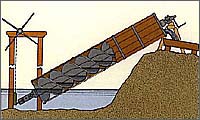| Back to . . . | This section . . . |
|
Below is the beginning of a recent article written by the Webmaster of this site (Chris Rorres) that appeared in the Journal of Hydraulic Engineering published by the American Society of Civil Engineers. The article is a technical discussion of the optimal design of an Archimedes screw. You can download a reprint of the complete article from the following link:R E P R I N T [PDF version (2.3 megabytes)]
An overview of this article can be found in Ivars Peterson's online column Math Trek of January 22, 2000.
By Chris Rorres
ABSTRACT: The geometry of an Archimedes screw is governed by certain external parameters (its outer radius, length, and slope) and certain internal parameters (its inner radius, number of blades, and the pitch of the blades). The external parameters are usually determined by the location of the screw and how much water is to be lifted. The internal parameters, however, are free to be chosen to optimize the performance of the screw. In this paper the inner radius and pitch that maximize the volume of water lifted in one turn of the screw are found. The optimal parameter values found are compared with the values used in a screw described by the Roman architect and engineer Vitruvius in the first century B.C., and with values used in the design of modern Archimedes screws.

FIG. 2. Profile of a Three-Bladed Archimedes Screw FIG. 9. Graph of the Volume-per-Turn Ratio versus the Radius Ratio and the Pitch Ratio for an 8-Bladed Screw |
INTRODUCTION One of the oldest machines still in use is the Archimedes screw, a device for lifting water for irrigation and drainage purposes. Its invention has traditionally been credited to Archimedes (circa 287-212 B.C.). For example, Diodorus Siculus (Greek historian, circa first century B.C.) writes men easily irrigate the whole of it [an island in the delta of the Nile] by means of a certain instrument conceived by Archimedes of Syracuse, and which gets its name [cochlias] because it has the form of a spiral or screw.And from Athenaeus of Naucratis (Greek historian, circa A.D. 200): The bilge-water [of the ship Syracusia], even when it became very deep, could easily be pumped out by one man with the aid of the screw, an invention of Archimedes.(See references under Diodorus Siculus and Athenaeus of Naucratis.) Archimedes, however, made no reference to it in his extant works [cf. Heath (1897) and Dijksterhuis (1938)], and it may be that he simply transmitted its knowledge from Egypt (where it is believed he studied in Alexandria under the students of Euclid) to Syracuse (his native city in Sicily). On the other hand, in defense of Archimedes: no mention of the device exists before his time, its design involves the type of geometry in which he excelled, and his abilities as an inventor of mechanical and military machines are well documented. The Roman engineer and architect Vitruvius gave a detailed and informative description of the construction of an Archimedes screw in his De Architectura, written in the first century B.C. (See reference under Vitruvius.) Vitruvius's description contributed greatly to keeping the device well known throughout the ages, and the particular screw he described will be used throughout this paper as a test case.
(End of excerpt)
|